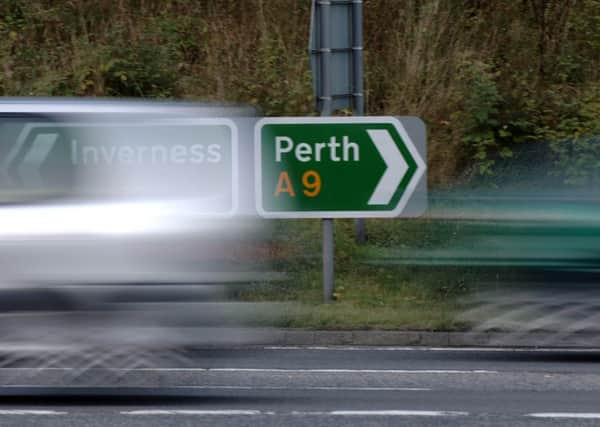More drivers speeding on dual carriageways of A9


One third more drivers were prosecuted for breaking the limit on dual carriageway sections of the road between Perth and Inverness in August to October last year compared to the same period in 2013.
The figures, obtained under Freedom of Information legislation, are the latest available before the average speed cameras went live in October over 80 miles of single carriageway.
Advertisement
Hide AdAdvertisement
Hide AdMobile camera vans caught 106 drivers on dual carriageways last August compared to 99 the year before, 92 in September (66 in 2013) and 76 in October (40).
The Scottish Government’s Transport Scotland agency has said that since camera installation started in April, “excessive speeding” had been cut in the sections they cover from around one in ten drivers to less than one in 700.
This is expected to be confirmed when figures for the first three months of camera operation are published tomorrow.
It is also thought there has been only one death on the A9 in the last four months compared to some eight in the whole of 2014 and nine in 2013.
A motoring group predicted the statistics would show relatively few drivers had been caught speeding by the cameras, but it backed a continued crackdown on dual carriageway offenders.
Neil Greig, the Scotland-based policy and research director of the Institute of Advanced Motorists, said: “The anecdotal view is that they will be low as drivers do seem to be behaving, and extreme speeding has reduced.
However, he added: “Police Scotland will certainly want to get the message out that the dual carriageways are being enforced in traditional ways.
“The IAM agree this is probably needed, otherwise we may see poor driver behaviour as a minority seek to overtake as much as possible or make up perceived ‘lost’ time.”
Advertisement
Hide AdAdvertisement
Hide AdThe average speed cameras, which measure speed over set distances, only cover single carriageway stretches between Perth and Inverness because these account for most deaths on that part of the road.
However, they also cover the dual carriageway section from Perth to the Keir roundabout, south of Dunblane, because of “high severity” crashes involving vehicles turning at cross-over junctions.
Mobile cameras are deployed on sections of dual carriageway north of Perth which have had a high number of serious crashes over the last three years.
FOLLOW US
-----------------------------------------
-----------------------------------------
SCOTSMAN TABLET AND MOBILE APPS
Information published by the Tayside and Northern Safety Camera partnerships show these are at the Inveralmond roundabout on the northern edge of Perth, Pitlochry and nearby Moulinearn, and over the three stretches north of Dalwhinnie.
Chief Superintendent Iain Murray, head of road policing for Police Scotland, said: “We maintain a proactive approach to the policing of the A9 to influence road user behaviour and prevent collisions.
“This includes the targeting of speeding and other risk behaviours that needlessly puts people in danger.”
“Mobile cameras on the A9 are deployed at a number of locations that meet the criteria set out in the Scottish Safety Camera Programme handbook.
“This varies from month to month, and the schedule is published on the relevant Safety Camera Partnership website.
Advertisement
Hide AdAdvertisement
Hide Ad“As a consequence, the number of offences recorded each month may vary depending on the locations that have been in use.”
A Transport Scotland spokesman said: “The A9 Safety Group [which also includes police and local authorities] will this week provide a detailed report on [the cameras’] initial performance, including offender and speeding data.
“It is clear the cameras are already having a positive impact.
“The number of closures and restrictions on the A9 between Dunblane and Inverness in 2014 was almost 22 per cent lower than in 2013, and the impact of those closures was reduced by over 40 per cent in 2014 compared to 2013.
“We are confident the new statistics will vindicate the difficult decision to install speed cameras, although there is clearly still a long way to go.”
“It is clear the cameras are already having a positive impact.
“It is important to stress the cameras are not happening in isolation. They are part of a comprehensive package of measures to make the A9 safer, including substantial investment in engineering improvements, such as improved lighting and signing, as well as education campaigns.”
SEE ALSO